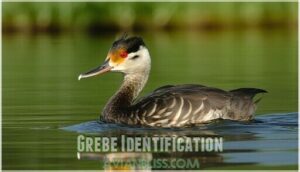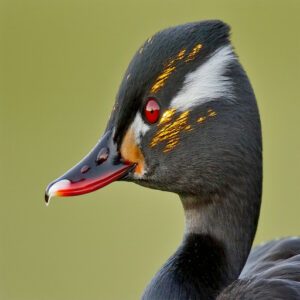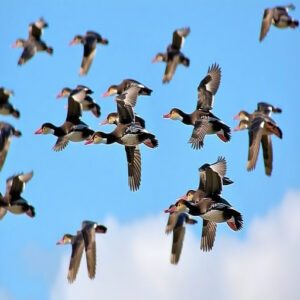This site is supported by our readers. We may earn a commission, at no cost to you, if you purchase through links.

These remarkable birds thrive in shallow, fish-free wetlands across western North America, building floating nests in calm waters surrounded by reeds.
During migration, they gather in huge flocks at sites like Mono Lake, fueling up on brine shrimp before continuing their nocturnal journeys.
In winter, you’ll find them in saltwater lakes or coastal areas, blending in with subtler plumage.
With lobed feet and sharp beaks, they’re expert swimmers and insect hunters.
Keep an eye out—there’s always more to discover about this elusive bird!
Table Of Contents
- Key Takeaways
- Eared Grebe Habitat
- Grebe Identification
- Eared Grebe Diet
- Breeding and Conservation
- Behavior and Migration
- Frequently Asked Questions (FAQs)
- Where does the eared grebe live?
- What is the difference between eared grebe and Horned Grebe?
- Are eared grebes endangered?
- What is the difference between eared grebe and pied billed grebe?
- Where do Eared Grebes live?
- Why are Eared Grebes flightless?
- What is the difference between Horned Grebe and eared grebe?
- Do Eared Grebes fly?
- How do Eared Grebes behave during courtship?
- What do chicks look like?
- Conclusion
Key Takeaways
- You’ll find eared grebes thriving in fish-free wetlands, building floating nests in shallow waters surrounded by reeds or aquatic vegetation.
- During migration, they gather at spots like Mono Lake to feast on brine shrimp before long nocturnal journeys.
- Their seasonal plumage shifts, with golden cheek wisps in summer and smudged gray tones in winter, making them easy to identify.
- Eared grebes are efficient underwater hunters, using their lobed feet and sharp beaks to catch aquatic insects and crustaceans.
Eared Grebe Habitat
You’ll find Eared Grebes in shallow lakes, ponds, and salty inland waters like Mono Lake and the Great Salt Lake.
They prefer areas without fish and use aquatic vegetation to build floating nests during breeding season.
Distribution and Range
Eared Grebes have a vast geographic spread, breeding across western North America in wetlands.
During fall migration, they flock to major staging areas like Mono Lake, Great Salt Lake, and Salton Sea.
Known for their nocturnal migration routes, these birds display fascinating habitat selection, favoring saline waters.
Those interested in eared grebe range can find related products online.
Their range expansion extends throughout North America, even reaching Guatemala during winter.
Breeding and Nesting Locations
Look for breeding colonies in shallow wetlands with plenty of aquatic vegetation.
These birds prefer shoreline habitats and nest placement in secluded spots near reeds or emergent plants.
Their floating nests, crafted with nesting materials like bent reeds, are anchored in calm waters.
You can find a variety of eared grebe nests online.
Wetland selection matters, as they need fish-free zones within their breeding range to thrive.
Migration Patterns
Each fall, eared grebes set out on impressive journeys, showcasing fascinating flight routes and seasonal movements.
Their migration timing begins earlier than many migratory birds, spanning late July through November.
These impressive migrations include months-long stopovers to refuel.
Key stopover sites include Mono Lake and the Great Salt Lake, where they rest and feed.
These flocks, often migrating by night, demonstrate remarkable flocking behavior, forming dense clusters.
Learn more on this eared grebe webpage.
Wintering Grounds
After long migrations, Eared Grebes settle into saltwater refuges and freshwater lakes for winter.
They primarily breed in large freshwater lakes and reservoirs, and you’ll find them in marine ecosystems like California’s Salton Sea or the Gulf Coast.
Their winter plumage helps them blend into coastal habitats, and they often gather near island sanctuaries or hypersaline lakes.
More information on Eared Grebes is available on this Eared Grebe webpage.
| Location | Ecosystem Type | Common Sighting |
|---|---|---|
| Salton Sea | Hypersaline Lake | Large congregations |
| Gulf Coast | Coastal Habitat | Scattered individuals |
| Mono Lake | Saltwater Refuge | Feeding and flocking activity |
Grebe Identification
You can identify an Eared Grebe by its small size, thin dark bill, and bright red eyes.
Look for the golden wisps on its cheeks during summer or its smudged gray plumage in winter.
Physical Characteristics
How can you tell a grebe bird apart? Focus on the beak shape—thin, straight, dark—and their standout bright red eye coloration.
Podiceps nigricollis has a compact body size with striking feather colors: black neck and golden cheek wisps in summer plumage, grayish tones with a white chin in winter plumage. Their distinctive head patterns complete the look.
Understanding eared grebe identification techniques is essential for accurate species recognition.
Differences From Horned Grebe
Sometimes, distinguishing between an eared grebe and a horned grebe feels like solving a puzzle.
Here’s how to tell them apart:
- Beak Shape: The eared grebe’s thin, upturned bill contrasts with the horned grebe’s heavier, straight bill.
- Eye Color: Both have red eyes, but horned grebes’ sit higher.
- Feather Patterns: Eared grebes show smudged cheek patches in winter.
- Head Structure: Horned grebes’ "horns" extend further.
- Podiceps Species: Eared grebes, Podiceps nigricollis, are smaller.
Understanding the horned grebe characteristics is essential for accurate identification of these birds.
Plumage and Coloration
The Eared Grebe’s plumage shifts with the seasons, making plumage identification easier.
In summer, you’ll notice dramatic black necks and golden “ear” feathers—signature color variations.
Winter coats are softer, with gray bodies and smudged white cheeks.
These molt cycles help you spot them year-round, and feather patterns, along with their striking changes, make these birds a true treat to identify, especially with their striking changes!
Bill and Eye Characteristics
Gold wisps near the eyes might catch your attention first, but the eared grebe’s dark, slightly upturned bill is a telltale clue.
Its bright red eyes sit lower on the head compared to other grebes, enhancing its unique look.
Combined with smudged facial markings and sleek head feathers, its distinctive bill shape and eye coloration help lock in identification.
Eared Grebe Diet
You’ll find the Eared Grebe focused on aquatic invertebrates like brine shrimp and brine flies, with occasional small fish or tadpoles added to the mix.
It uses its lobed feet to propel through water, expertly catching prey by diving and swimming underwater.
Feeding Habits and Behavior
This diving bird masters social foraging, often gathering in groups to hunt aquatic prey like insects and crustaceans.
With sharp diving techniques and feeding adaptations, the eared grebe glides underwater, using lobed feet to maneuver swiftly.
Its feeding behavior is efficient—scouring shallow waters or plucking food from the surface, making the eared grebe a skilled underwater hunter with effective foraging strategies.
Primary Food Sources
You’ll find the Eared Grebe snacking on aquatic insects, brine shrimp, and crustaceans, with occasional bites of mollusks, tadpoles, or small fish.
Their diet revolves around shallow waters rich in tiny prey, like brine shrimp during migration.
Notably, these birds even consume their own feathers, feeding them to their young—an unusual but essential habit for digestion and protection.
The Eared Grebe’s foraging methods differ from those of birds relying on deep water diving to catch fish as their primary food source.
Foraging Techniques
You know these aquatic birds have some unique tricks regarding snagging prey.
Their foraging behaviors are impressive, combining agility with precision underwater.
- Diving methods: Eared grebes swim swiftly, using lobed feet to maneuver while chasing aquatic invertebrates.
- Feeding strategies: They skim the water’s surface or go deep after prey.
- Prey capture: Tiny crustaceans and insects are their main targets.
Adaptations for Feeding
The eared grebe’s thin, dark beak is perfect for snatching insects and small crustaceans.
Its lobed feet help it maneuver underwater with ease, mastering diving techniques for efficient hunting.
Below is a quick glance at its feeding adaptations:
| Adaptation | Purpose | Example Behavior |
|---|---|---|
| Thin Beak Structure | Grabbing tiny prey items | Catching aquatic insects |
| Lobed Feet | Underwater propulsion | Diving for crustaceans |
| Foraging Methods | Surface gleaning and diving | Collecting brine shrimp |
Breeding and Conservation
You’ll find eared grebes nesting in shallow lakes and ponds, using floating platforms made of plants to anchor their eggs.
While their populations are stable, habitat loss and climate change threaten their key staging and breeding areas.
Reproduction and Nesting
Eared Grebes are experts at nest construction, creating floating platforms of reeds and aquatic plants in shallow, fish-free water.
Their nests, anchored to vegetation, cradle a clutch size of 1-8 eggs.
Parents share duties like egg laying and fastidious brood rearing.
Once hatched, fledgling development kicks off as chicks leave the nest, often hitching rides on their parents’ backs.
Egg Characteristics and Incubation
Eggs typically start whitish but turn brown from nest stains, they’re oval-shaped, with lengths around 1.8 inches and widths near 1.2 inches.
Incubation periods last about 21 days.
Both parents share the job, sitting on nests made of:
- Bent-over reeds
- Floating aquatic plants
- Shallow water vegetation
- Tightly woven materials
- Anchored plant structures
The incubation periods and nest construction are critical aspects of their breeding behavior.
Conservation Status and Threats
Populations are stable but vulnerable due to habitat destruction and wetland drainage.
Climate threats, like droughts and temperature shifts, impact breeding grounds.
Eared Grebes face avian diseases, such as cholera, leading to mass die-offs.
Despite their "Least Concern" conservation status, population decline risks grow without protecting critical habitats.
Conservation efforts target preserving wetlands and managing water resources responsibly, which can help mitigate the effects of climate threats.
Habitat Loss and Climate Change
Wetland degradation and habitat loss are huge problems for Eared Grebes, thanks to climate change and human activities.
Rising temperatures and drought worsen habitat fragmentation, disrupting their nesting and migration routines.
These climate threats also jeopardize key staging areas like Mono Lake.
Conservation efforts focus on protecting wetlands, ensuring these resilient birds can adapt to ecosystem disruptions while maintaining their stable conservation status, aided by addressing habitat loss.
Behavior and Migration
You’ll find Eared Grebes gathering in large flocks during migration, showcasing their highly social nature.
These birds prepare for lengthy flights with remarkable physiological changes, increasing fat stores and boosting their flight muscles.
Social Behavior and Flocking
Among social birds, the Eared Grebe shines with fascinating flocking patterns and colony behavior.
These bird species form tight group dynamics, especially during breeding seasons.
You’ll spot them diving and socializing together in large colonies.
Here’s what to know:
- They create colonies on shallow lakes.
- Flocks migrate together.
- Mating rituals strengthen social bonds.
- Group cohesion aids survival.
Migration Patterns and Routes
Eared grebes follow impressive seasonal movements, traveling along key migration routes.
Their Flyway Analysis highlights major stopover sites like Mono Lake and the Great Salt Lake, essential for resting and refueling.
Migration timing peaks in late summer and fall, with birds optimizing routes for night travel.
Detailed migration maps show how these migratory birds depend on specific staging areas for survival.
The birds’ ability to use bird migration patterns is essential for their survival during these long journeys, leveraging bird migration patterns for success.
Physiological Changes for Migration
Before migration, eared grebes go through drastic physiological changes.
They pack on body fat for energy reserves, allowing non-stop flights.
Muscle growth bolsters their stamina, while organ shrinking, like digestive systems, redirects energy to flight.
These metabolic adjustments happen at key staging areas, ensuring survival during challenging journeys.
It’s nature’s way of prepping them for long-haul travel.
Understanding bird behavior migration patterns is vital to appreciating the nuances of their journeys and the importance of bird behavior.
Behavioral Traits and Courtship Displays
During mating rituals, eared grebes perform intricate courtship dances that showcase synchronized swimming, diving, and running across water.
These display behaviors strengthen pair formation and social bonding, as partners gracefully rear up and move side by side, turning heads in rhythm.
These behaviors are essential for nesting success, as courtship displays cement connections needed for collaborative parenting, which is a crucial aspect of social bonding.
Grebe behavior truly fascinates!
Frequently Asked Questions (FAQs)
Where does the eared grebe live?
Imagine a bird that loves both quiet marshes and salty party spots—they thrive in shallow lakes, ponds without fish, and salty inland waters like Mono Lake.
They breed in wetlands and migrate to coastal bays.
What is the difference between eared grebe and Horned Grebe?
Spot the difference by their "hairstyles."
Horned Grebes have longer, horn-like golden feathers reaching back, while Eared Grebes flaunt shorter, ear-like tufts.
Horned Grebes also show a heavier bill and higher-set eyes.
Are eared grebes endangered?
Picture a bird coping with life’s ups and downs—eared grebes aren’t endangered, but their reliance on specific wetlands makes them vulnerable.
Habitat loss, climate change, and pollution could tip the balance if we’re not careful.
What is the difference between eared grebe and pied billed grebe?
Spot the difference by focusing on their bills: the pied-billed grebe has a thick, pale bill with a black stripe.
While the eared grebe showcases a thin, dark bill, plus striking red eyes.
Where do Eared Grebes live?
Imagine a nomad of the wetlands, thriving in shallow lakes without fish.
You’ll spot them breeding in marshy ponds or gathering in saltier spots like Mono Lake and the Great Salt Lake during migration.
Why are Eared Grebes flightless?
These small birds temporarily lose flight as their feathers molt all at once, leaving them grounded.
It’s like taking a forced vacation to focus on fat reserves and muscle buildup before their long migrations.
What is the difference between Horned Grebe and eared grebe?
Think of the Horned Grebe as the flashy sibling with "horns" of gold stretching back, while the Eared Grebe rocks shorter "ears."
Horned eyes sit higher, and their heavier bills tip pale.
Subtle but striking contrasts!
Do Eared Grebes fly?
Yes, they fly, but not often.
Before migration, they prep with months of rest, feeding, and body changes.
Once ready, they take off at night for long, determined flights to reach their next destination.
How do Eared Grebes behave during courtship?
During courtship, you’ll see them perform intricate dances—bobbing heads, mirroring movements, and even "walking" on water.
These displays, paired with their golden facial wisps, create a strikingly synchronized show to attract a mate.
What do chicks look like?
Chicks are fluffy, with soft gray down that blends to whitish underneath.
Their small bills and bright eyes give a curious look.
Often seen riding a parent’s back, they’re surprisingly independent swimmers within days.
Conclusion
Spotting an eared grebe feels like uncovering a secret of nature—they’re striking yet elusive.
From their fiery eyes to their unique plumage, these birds thrive in wetlands, migrate under moonlit skies, and winter near saltwater shores.
Their diet of brine shrimp and insects fuels their incredible endurance, while their lobed feet and sharp beaks highlight their expert adaptations.
Keep your binoculars handy, explore their habitats, and embrace the joy of observing this fascinating species in action.












